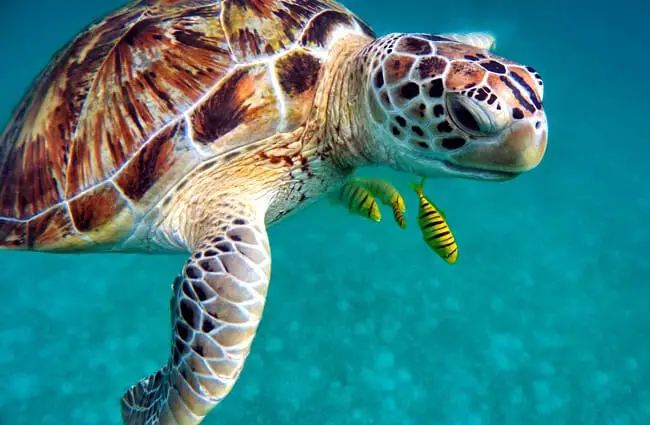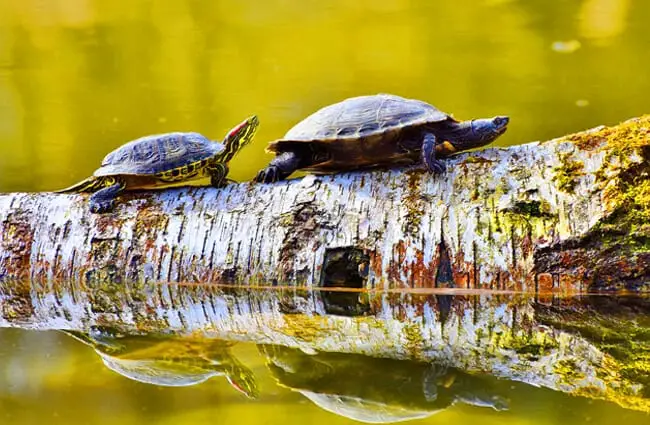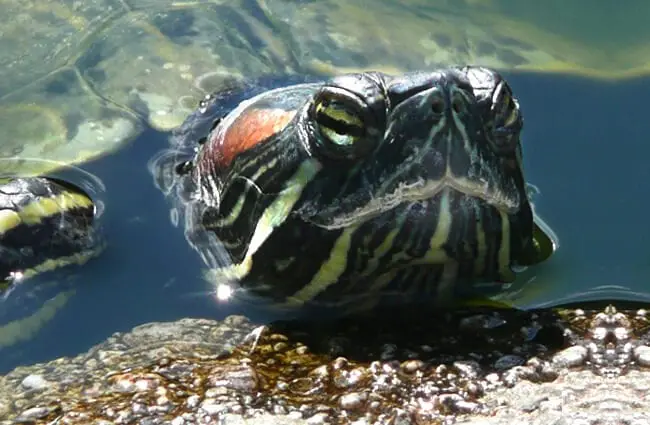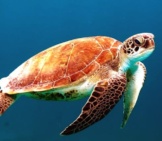These shelled reptilians can be found nearly worldwide. Turtles and tortoises are easily identified by their bony or cartilaginous shells. This shell helps protect turtles and tortoises from predators, and is actually developed from their rib bones! Read on to learn about the turtle.
Description of the Turtle
There are over 356 different species of turtles and tortoises. Turtles in particular (as opposed to tortoises) are aquatic reptiles with webbed feet and hard shells. Their jaws are equipped with hard beaks that help them capture and cut apart food. Some species of turtles have eyes and nostrils situated on the tops of their heads, so that they can hide easily in shallow water.
Interesting Facts About the Turtle
With such a huge variety of species, there are virtually endless fascinating facts about turtles. Some species have traits unique to them in particular, and some adaptations are held by all turtle species.
- Stupendous Shells – Turtle shells are an amazing evolutionary adaption. The shell is fused to the ribs and backbone of the turtle, making it impossible for it to leave its shell. The top half of the shell is called a carapace, and the bottom half is called a plastron.
- Personal Protection – Their unique shells provide these animals with a mobile protection system. When presented with danger, a turtle retracts its head and legs inside its shell. This keeps predators from being able to reach its vital body parts.
- Shell-Less Turtles? – While all turtle species have shells, not all species have hard Some kinds of aquatic turtles have soft, leathery shells instead of hard shells! Leatherback sea turtles and softshelled turtles are two examples.
- Turtle for Dinner – Turtles are considered a delicacy in China, and are also used in traditional Chinese medicine. In the United States, nearly 97% of those harvested per year are exported to Asia. Some of these are farm raised, and some are wild caught.
- Turtle vs. Tortoise – There are a few differences between turtles and tortoises. Tortoises are exclusively land-dwelling animals, and if they are put in deep water they will drown. While tortoises are technically turtles, not all turtles are tortoises. The best way to tell the difference between the two is to look at their feet! Tortoises have elephant-like, unwebbed feet, and turtles have webbed feet for swimming.
Habitat of the Turtle
There are many different species of turtles and tortoises that inhabit a wide variety of habitats. You can find aquatic turtles in the ocean (sea turtles), lakes, rivers, ponds, streams, wetlands, estuaries, and more. Tortoises can be found in rainforests, deserts, coastal dunes, deciduous forests – virtually any non-polar habitat.
Distribution of the Turtle
These fascinating animals are found almost worldwide. Sea turtles can be found in all oceans, except for the north and south poles. Turtles and tortoises can be found in North, South, and Central America, Africa, Australia, and Eurasia. Because they are cold-blooded, colder temperatures restrict their northernmost range.
Diet of the Turtle
Different species eat different types of food. Some are carnivores, and some are herbivores. Carnivorous species eat fish, frogs, snakes, small mammals, and birds. Herbivores will eat a variety of vegetation including grasses, reeds, algae, and roots. Because each species is different, it is important to look them up individually to determine proper dietary needs.
Turtle and Human Interaction
These amphibians are widespread, and frequently interact with humans in a number of different ways. Humans threaten their populations via direct harvesting, as well as having indirect impacts. They are hunted for meat in a number of different countries, and this meat is frequently exported to Asia for consumption. They are also impacted by deforestation and land development, and struck by cars while attempting to cross roads.
Domestication
Some species of turtles have been domesticated for farming and the pet industry. Some commonly kept species are red-eared sliders, Russian tortoises, spur-thighed tortoises, softshell turtles, and more.
Does the Turtle Make a Good Pet
Turtles can make very good pets. When choosing one, make sure you research the species you plan on purchasing so you fully understand its needs. Always make sure you are purchasing a captive-bred animal.
Turtle Care
Each species will have different specific needs. If you are purchasing an aquatic turtle, you will need to provide swimming opportunities, while also allowing plenty of space to haul out of the water and get some sun. Most species can be fed commercial pellets supplemented with veggies, fruits, crickets, and other types of treats. As a cold-blooded animal, you will need to provide a heat source for your turtle as well.
Behavior of the Turtle
All species of turtles, even the aquatic ones, must breathe air. Some species are nearly entirely aquatic, like sea turtles, while others spend all their time on land. With the vast number of turtle species, there is a wide variety of behaviors that may be displayed. Some are solitary, and only interact with others to mate. Others are more social, and can aggregate in large numbers while sunning or feeding.
Reproduction of the Turtle
Turtles lay soft, leathery eggs. After mating, the female will dig a nest in sand or mud, and bury the eggs. Some eggs are spherical in shape, while others are more elongated.
The temperature of the eggs while they are incubating determines the sex of the babies. Most eggs will hatch after 70 – 120 days of incubating. All species of turtles are fully independent when they hatch, and no maternal care has been seen in any turtle species.
Beliefs, Superstitions, and Phobias About the Turtle
These animals are commonly found in ancient folklore. For example, Native American folklore commonly includes turtles as a positive symbol or being. Some East Coast Native American tribes believe that the Great Spirit created the land by situating the earth on the back of a giant turtle. Some Native Americans even refer to North America as “Turtle Island” because of this tale.











![Red Angus Closeup of a beautiful Red Angus cowPhoto by: U.S. Department of Agriculture [pubic domain]https://creativecommons.org/licenses/by/2.0/](https://animals.net/wp-content/uploads/2020/03/Red-Angus-4-238x178.jpg)












![Red Angus Closeup of a beautiful Red Angus cowPhoto by: U.S. Department of Agriculture [pubic domain]https://creativecommons.org/licenses/by/2.0/](https://animals.net/wp-content/uploads/2020/03/Red-Angus-4-100x75.jpg)

